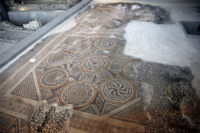 The world’s largest intact mosaic will open to the public this year in Antakya, Turkey, as part of the newly built Antakya Museum Hotel. The 1,300-year-old, 9,000-square-foot mosaic was discovered in 2010. Archaeologists believe this vast mosaic with intricate geometries was the floor of a public building in the ancient city of Antioch. It was damaged during a series of major earthquakes in 526 and 528 A.D., but some of that damage only enhances its spectacular visual qualities because the mosaic remained connected to the floor and mostly intact even as the foundation itself undulated wildly.
The world’s largest intact mosaic will open to the public this year in Antakya, Turkey, as part of the newly built Antakya Museum Hotel. The 1,300-year-old, 9,000-square-foot mosaic was discovered in 2010. Archaeologists believe this vast mosaic with intricate geometries was the floor of a public building in the ancient city of Antioch. It was damaged during a series of major earthquakes in 526 and 528 A.D., but some of that damage only enhances its spectacular visual qualities because the mosaic remained connected to the floor and mostly intact even as the foundation itself undulated wildly.
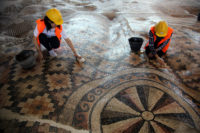 Founded in 300 B.C. by one of Alexander the Great’s successor generals Seleucus I Nicator, Antioch was the capital of the Seleucid Empire until it was conquered by Rome in 63 B.C. and became the seat of the governor. Its location made it a hub of trade between the Mediterranean and the East. At its peak, Antioch had a population of half a million and was so important that it was considered a rival first to Alexandria and then to Constantinople as the second most important city in the Empire.
Founded in 300 B.C. by one of Alexander the Great’s successor generals Seleucus I Nicator, Antioch was the capital of the Seleucid Empire until it was conquered by Rome in 63 B.C. and became the seat of the governor. Its location made it a hub of trade between the Mediterranean and the East. At its peak, Antioch had a population of half a million and was so important that it was considered a rival first to Alexandria and then to Constantinople as the second most important city in the Empire.
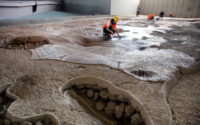 Today Antakya is internationally known for the great number and high quality of mosaics that have been found under its streets. The Hatay Archaeological Museum has a collection of Roman mosaics that is without peer, most of them lifted from excavations and conserved indoors. So it was not unexpected when construction of a new hotel revealed a spectacular late Roman mosaic. The approach taken to its preservation, however, diverged from the well-trodden path of earlier discoveries.
Today Antakya is internationally known for the great number and high quality of mosaics that have been found under its streets. The Hatay Archaeological Museum has a collection of Roman mosaics that is without peer, most of them lifted from excavations and conserved indoors. So it was not unexpected when construction of a new hotel revealed a spectacular late Roman mosaic. The approach taken to its preservation, however, diverged from the well-trodden path of earlier discoveries.
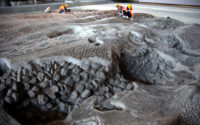 The sheer enormity of the mosaic required a different plan of action. Instead of lifting the mosaic, or part of it, or covering it for its own protection and building over it, archaeologists and architects worked together to create a hybrid: a museum hotel. The Antakya Museum Hotel, located near the Church of St. Peter, a crusader-era church built around a cave believed to be one of the earliest Christian churches in the world, would be built using the archaeology of the site as a lodestar.
The sheer enormity of the mosaic required a different plan of action. Instead of lifting the mosaic, or part of it, or covering it for its own protection and building over it, archaeologists and architects worked together to create a hybrid: a museum hotel. The Antakya Museum Hotel, located near the Church of St. Peter, a crusader-era church built around a cave believed to be one of the earliest Christian churches in the world, would be built using the archaeology of the site as a lodestar.
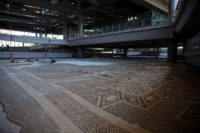 EAA-Emre Arolat Architecture placed structural columns along the a former riverbed that crosses through the middle of the site and outside the perimeter of the mosaic. They built a platform on top of the columns to house the hotel’s amenities — ballroom, conference rooms, pool, gym — with passageways and viewing points for guests to view the incredible archaeology beneath them. The rooms are prefabricated units stacked on top of each other, which reduced the amount of on-site construction and the potential damage to the mosaic. The walkways and bridges that connect the rooms create an open space where the archaeology is in sight throughout the building.
EAA-Emre Arolat Architecture placed structural columns along the a former riverbed that crosses through the middle of the site and outside the perimeter of the mosaic. They built a platform on top of the columns to house the hotel’s amenities — ballroom, conference rooms, pool, gym — with passageways and viewing points for guests to view the incredible archaeology beneath them. The rooms are prefabricated units stacked on top of each other, which reduced the amount of on-site construction and the potential damage to the mosaic. The walkways and bridges that connect the rooms create an open space where the archaeology is in sight throughout the building.
When is a floor not a floor?
Two thoughts- one is that the swaying floor makes one feel you are on a very stormy boat. Two- what a great compromise between history preservation and commerce. I would love to stay at that hotel.
Great work.
Dates are incorrect.not 1300 years.2400.
Also not correct. Rather 1600-1700 years old (4th century AD)